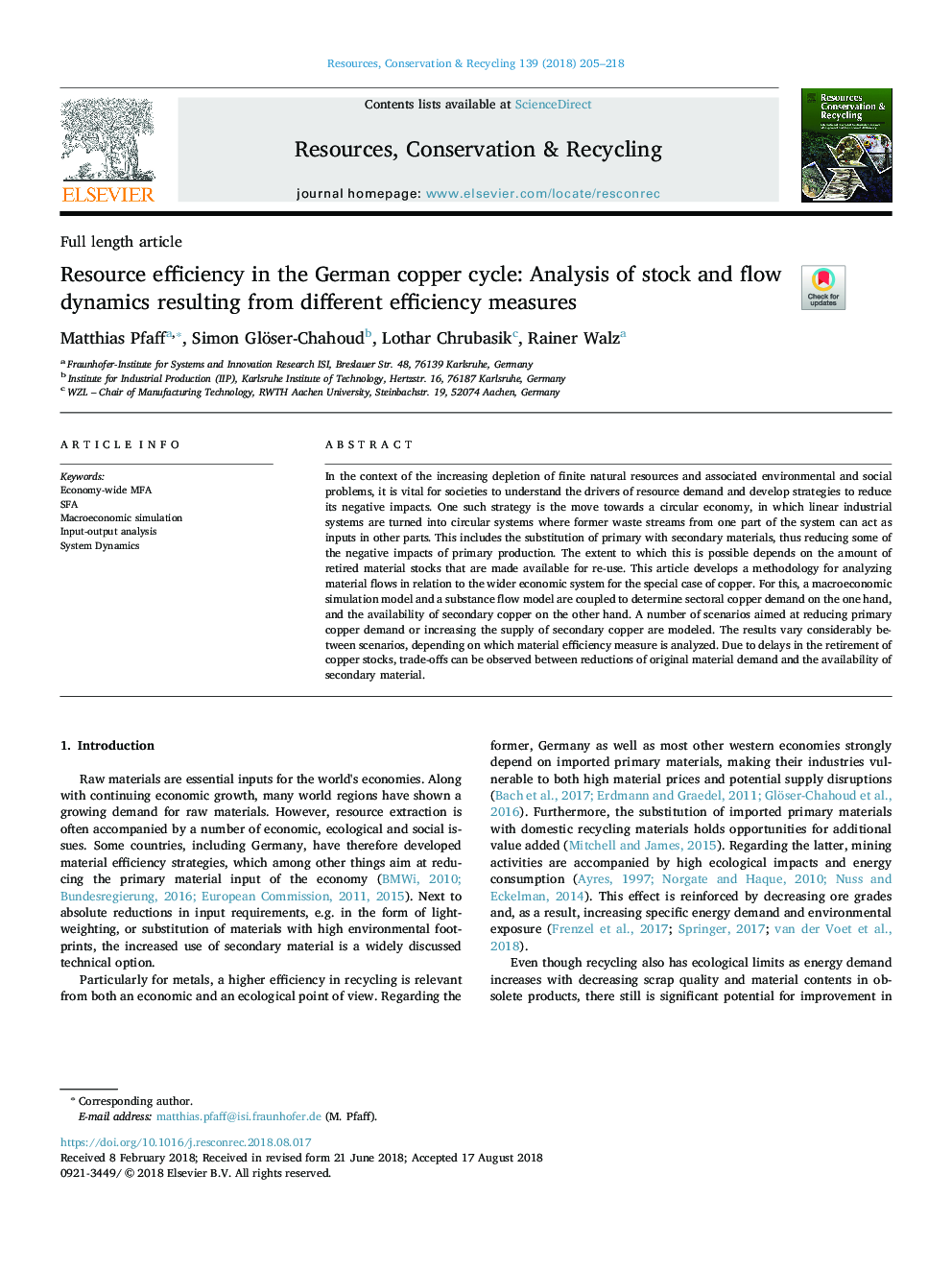| کد مقاله | کد نشریه | سال انتشار | مقاله انگلیسی | نسخه تمام متن |
|---|---|---|---|---|
| 11005402 | 1485653 | 2018 | 14 صفحه PDF | دانلود رایگان |
عنوان انگلیسی مقاله ISI
Resource efficiency in the German copper cycle: Analysis of stock and flow dynamics resulting from different efficiency measures
ترجمه فارسی عنوان
کارایی منابع در چرخه مس آلمان: تجزیه و تحلیل پویایی سهام و جریان ناشی از اقدامات مختلف بهره وری
دانلود مقاله + سفارش ترجمه
دانلود مقاله ISI انگلیسی
رایگان برای ایرانیان
کلمات کلیدی
ترجمه چکیده
در زمینه کاهش منابع طبیعی محدود و مشکلات مربوط به محیط زیست و اجتماعی، جوامع برای درک رانندگان تقاضای منابع و ایجاد استراتژی برای کاهش اثرات منفی آن ضروری است. یکی از این استراتژی ها، حرکت به سوی یک اقتصاد دایره ای است که در آن سیستم های صنعتی خطی به سیستم های دایره ای تبدیل می شوند که زباله های سابق از یک بخش از سیستم می تواند به عنوان ورودی در سایر قسمت ها عمل کند. این شامل جایگزینی اولیه با مواد ثانویه است، بنابراین برخی از اثرات منفی تولید اولیه را کاهش می دهد. میزان این امکان بستگی به مقدار سهام بازنشستگان که برای استفاده مجدد قابل استفاده هستند. این مقاله روش شناسی برای تحلیل جریانهای مادی را در ارتباط با سیستم اقتصادی گسترده تر برای مورد خاص مس توسعه می دهد. برای این منظور، یک مدل شبیه سازی اقتصاد کلان و یک مدل جریان جریان مواد برای تعیین تقاضای مس تقاضا از یک سو و دسترسی به مس ثانویه از سوی دیگر متصل می شوند. تعدادی از سناریوها برای کاهش تقاضای مس اولیه و یا افزایش عرضه مس ثانویه مدل سازی شده است. نتایج به طور قابل ملاحظه ای بین سناریوها متفاوت است، بسته به کدام روش اندازه گیری راندمان مواد، تحلیل می شود. با توجه به تاخیر در بازنشستگی سهام مسی، می تواند بین کاهش تقاضای اصلی مواد و در دسترس بودن مواد ثانویه مشاهده شود.
موضوعات مرتبط
مهندسی و علوم پایه
مهندسی انرژی
انرژی های تجدید پذیر، توسعه پایدار و محیط زیست
چکیده انگلیسی
In the context of the increasing depletion of finite natural resources and associated environmental and social problems, it is vital for societies to understand the drivers of resource demand and develop strategies to reduce its negative impacts. One such strategy is the move towards a circular economy, in which linear industrial systems are turned into circular systems where former waste streams from one part of the system can act as inputs in other parts. This includes the substitution of primary with secondary materials, thus reducing some of the negative impacts of primary production. The extent to which this is possible depends on the amount of retired material stocks that are made available for re-use. This article develops a methodology for analyzing material flows in relation to the wider economic system for the special case of copper. For this, a macroeconomic simulation model and a substance flow model are coupled to determine sectoral copper demand on the one hand, and the availability of secondary copper on the other hand. A number of scenarios aimed at reducing primary copper demand or increasing the supply of secondary copper are modeled. The results vary considerably between scenarios, depending on which material efficiency measure is analyzed. Due to delays in the retirement of copper stocks, trade-offs can be observed between reductions of original material demand and the availability of secondary material.
ناشر
Database: Elsevier - ScienceDirect (ساینس دایرکت)
Journal: Resources, Conservation and Recycling - Volume 139, December 2018, Pages 205-218
Journal: Resources, Conservation and Recycling - Volume 139, December 2018, Pages 205-218
نویسندگان
Matthias Pfaff, Simon Glöser-Chahoud, Lothar Chrubasik, Rainer Walz,
